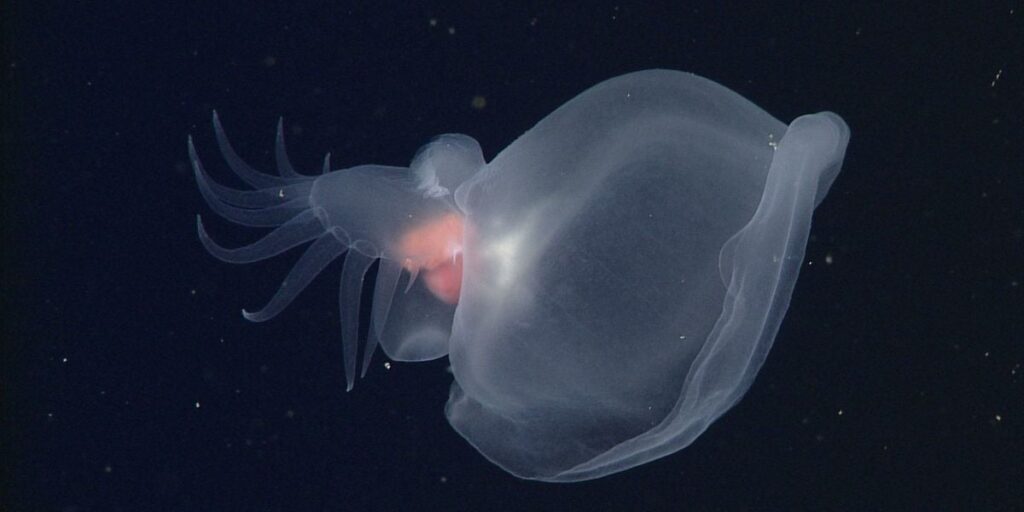The creature lives in the “midnight zone,” an area of the ocean so deep that sunlight never reaches it.
Monterey Bay Aquarium Research Institute
In February 2000, scientists spotted an unusual, glowing creature swimming 8,576 feet beneath the surface of the Pacific Ocean. They were using a remotely operated underwater vehicle to explore the “midnight zone” off the coast of central California, an area so deep that sunlight never reaches it. The bioluminescent animal didn’t match up with anything they’d seen before, so they nicknamed it the “mystery mollusk.”
“It sort of looks like it was made up from spare parts left over from making a bunch of other animals,” says Bruce H. Robison, an ecologist at the Monterey Bay Aquarium Research Institute, to NPR’s “Short Wave.”
Now, more than two decades later, researchers say they’ve identified the elusive creature. It’s a new species of sea slug that they’ve named Bathydevius caudactylus, they report this week in the journal Deep-Sea Research Part I.
After that first encounter in 2000, researchers went looking for more B. caudactylus specimens to get a better idea of what they had found. They returned to the same spot they saw the first one, called Monterey Submarine Canyon, but also explored new areas off the coast of California. The team ventured up to Oregon, and they even spotted a few of the mystery mollusks in the Mariana Trench in the western Pacific. In the end, they observed 157 individuals.
Most of the creatures they found were between about 3,300 and 10,700 feet deep, where water temperatures were around 36 degrees Fahrenheit. But a handful lived even deeper, in habitats up to 13,150 feet below the surface. Many B. caudactylus were alone, but a few were found swimming near each other.
To better understand the animal’s identity, the team collected a few B. caudactylus specimens and sequenced their DNA. This analysis showed the creature was a new species that belonged to a previously unknown family of nudibranch, or sea slug. And that, researchers say, was astounding.
“The deep water column is maybe the last place you’d expect to find a nudibranch,” Robison tells CNN’s Ashley Strickland. “It’s sort of like finding hummingbirds near the peak of Mt. Everest.” Still, he adds, “almost every aspect of Bathydevius reflects an adaptation to this habitat: anatomy, physiology, reproduction, feeding, behavior; it’s unique.”
B. caudactylus is an ethereal-looking creature with a gelatinous, transparent body. It has a large, bell-shaped hood atop its head; a fringed tail with between 9 and 16 finger-like appendages; and a short, cylindrical foot protruding from its middle. Its red stomach and orangish-brown digestive gland are visible within its see-through body.
The creatures use their hoods to trap prey—primarily shrimp—with a technique akin to how a Venus flytrap captures bugs. To move through the water, they either drift on the current or flex their bodies up and down.
Most of the time, B. caudactylus simply relies on its transparent body to avoid being seen by predators. But, if necessary, it can startle predators by lighting up with bioluminescence. In some instances, it can even shed one of its finger-like tail appendages as a distraction.
“Those dactyls fall off like a lizard dropping its tail,” Robison tells the East Bay Times’ Rita Aksenfeld. “If they turn off the lights in the rest of the body, and just that glowing, wiggling dactyl is visible, then the predator may go for the decoy rather than the animal itself.”
When it needs to make a speedy escape, B. caudactylus can shut its hood quickly to propel itself out of harm’s way.
In another adaptation to its deep-sea environment, B. caudactylus has both male and female sex organs, though researchers never observed the species mating. When it’s time to release eggs, the mollusk floats down to the seafloor, where it anchors itself with its foot.
“In the habitat where they live, opportunities to find a potential mate are few and far between,” Robison tells the East Bay Times. “But you double your chances of success if both individuals carry both sets of sex organs.”
The roughly 3,000 known species of nudibranchs come in a variety of shapes, sizes and colors. Since the animals lack shells to protect themselves, they use their coloring to either warn predators to stay away or to camouflage against their surroundings. Some have evolved the ability to steal stinging cells from their prey and reuse them.
Nudibranchs primarily eat jellyfish, anemones, sponges and other aquatic invertebrates—but some are cannibalistic. Two other nudibranchs use hoods to trap their prey, but they are only distantly related to B. caudactylus. This indicates that the mystery mollusk’s feeding method probably evolved independently several times.
Though nudibranchs live in oceans all over the world, researchers say B. caudactylus is the first known to live in the deep water column.
More broadly, the discovery of B. caudactylus demonstrates just how little scientists know about the ocean—and the deep ocean, in particular.
“For there to be a relatively large, unique and glowing animal that is in a previously unknown family really underscores the importance of using new technology to catalog this vast environment,” study co-author Steven H.D. Haddock, a marine biologist at the Monterey Bay Aquarium Research Institute, says in a statement. “The more we learn about deep-sea communities, the better we will be at ocean decision-making and stewardship.”


